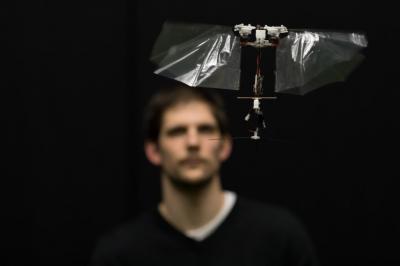Autonomous flapping robot mimics fruit fly manoeuvres
Engineers from TU Delft in the Netherlands have created an agile, autonomous flying robot that uses flapping wings to control its flight in a similar way to a fruit fly.

Known as DelFly Nimble, the robot is helping researchers to better understand the mechanics of insect flight and has potential for a range of new drone applications. Insects use their wings to power and direct their flight, allowing them to hover efficiently as well as accelerate and escape from danger rapidly. DelFly Nimble mimics this capability, beating its wings 17 times per second to stay airborne and also control its flight through subtle changes in wing motion.
“The robot has a top speed of 25km/h and can even perform aggressive manoeuvres, such as 360-degree flips, resembling loops and barrel rolls,” said TU Delft’s Matěj Karásek, first author of the study, which is published in Science. “Moreover, the 33cm wingspan and 29g robot has, for its size, excellent power efficiency, allowing five minutes of hovering flight or more than a 1km flight range on a fully charged battery.”
Register now to continue reading
Thanks for visiting The Engineer. You’ve now reached your monthly limit of news stories. Register for free to unlock unlimited access to all of our news coverage, as well as premium content including opinion, in-depth features and special reports.
Benefits of registering
-
In-depth insights and coverage of key emerging trends
-
Unrestricted access to special reports throughout the year
-
Daily technology news delivered straight to your inbox










National Gas receives funding to develop Gravitricity underground hydrogen storage system
One single rock salt mine - Winsford - has 23 <i>MILLION </i>cubic metres of void and even allowing for 10% of that void set aside for hazardous waste...